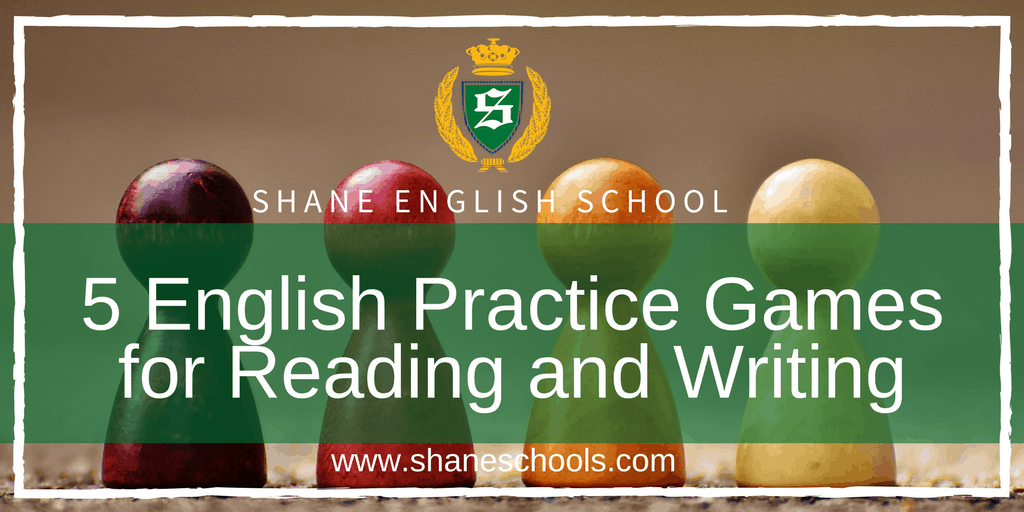[vc_row][vc_column][vc_column_text]
It’s just not possible to have too many English practice games at your disposal. They assist in both learning and retention by engaging students in a positive way. Here are 5 English games to helps students practice their reading and writing.
In case you’re wondering, this is why you should play games in class.
Alphabet Relay
This game is great for young learners.
Line up two teams, ideally of 4 or more players, as far from the whiteboard as possible. The first members of each team are given a pen and the teacher shouts “A”. Thereafter, each member runs to the board in turn, writes the next letter of the alphabet, and runs back to the next team member to hand over then pen. As your class get older and better at English, you can use more difficult target language and grammars in this game, using the same basic game rules.
Longest Sentence
Make a list of 50 words, including nouns, verbs, adjectives, adverbs, prepositions, conjunctions, etc. depending on level, and task the teams with creating the longest possible sentence they can. You can make this a writing game, or use cut-out pieces of paper with words on them that the students have to put together into sentences. You can make rules about the number of adjectives, nouns, etc. that must be used or a grammar pattern that must be followed. It all depends on the level of your students.
Phonics Wheel of Fortune
This game is best suited to younger phonics learners.
Draw a circle on the board with one or two desired phonics in the middle, e.g. aw, or, ee, etc. Around the outside of the circle write 10 initial and final phonics (f, d, th, ch, etc). The teacher shouts a word and the students have to run and stick a magnet on the initial, middle, and final phonics that make the word, then sit down and shout it out.
Phonics Teamwork Race
Again, this game is best suited to younger phonics learners.
This works with three players per team and is for use when practising phonics such a, a_e, i_e, etc. Write the phonic you’re practising on the board and surround it with magnets of other phonics, e.g., a_e written and surrounded by f, t, d, p, th, etc. The teacher shouts a word. Player one grabs the magnet of the initial phonic, player 2 the phonic from the middle, and player three places both magnets into the word. For example, if the word is gate, player one will grab g, player two t, and player three will stick them into a_e in the correct place. When they have done, the team sits down and reads the word to win.
Guess It
This game is also best suited for younger students learning phonics.
The “Guess It” game will teach students how to blend several letters to make common words. To begin, the teacher will divide the students into two groups. The teacher will then choose a word and segment it on the whiteboard (e.g., c-at). One team will have a chance to blend the word. If they blend it correctly, they will receive a point. If they do not correctly blend it, the other team will have the chance to blend and identify it. Each team will take turns blending words. The game is complete when one of the teams correctly blends 20 words.
For more game ideas, go here or here.
A version of this article originally appeared in Shane English School’s Teaching English to Young Learners (TEYL) program, which is part of new teachers’ orientation.[/vc_column_text][/vc_column][/vc_row][vc_row][vc_column][vc_separator][/vc_column][/vc_row][vc_row css=”.vc_custom_1534752216040{background-color: #ededed !important;border-radius: 2px !important;}”][vc_column width=”2/3″][vc_column_text]
Click here to take your teaching to the next level with 20% off a TEFL certificate from ITTT.
[/vc_column_text][vc_column_text]
Looking for teaching opportunities? Check out Saxoncourt Recruitment for teaching jobs abroad.
[/vc_column_text][/vc_column][vc_column width=”1/3″][vc_single_image image=”11062″ img_size=”medium” alignment=”center” onclick=”custom_link” link=”https://www.teflcourse.net/?cu=DYAJM2017I”][vc_single_image image=”10436″ img_size=”medium” alignment=”center” onclick=”custom_link” link=”www.saxoncourt.com?utm_source=Shane%20Schools&utm_medium=blog%20post&utm_campaign=Shane%20Schools%20blog%20footer”][/vc_column][/vc_row][vc_row][vc_column][vc_separator][/vc_column][/vc_row]

